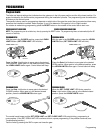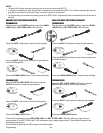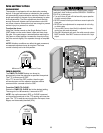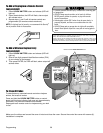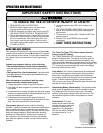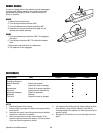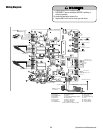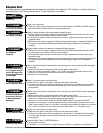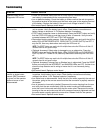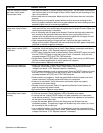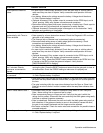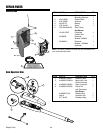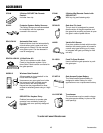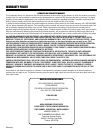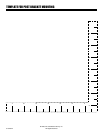
SYMPTOM POSSIBLE SOLUTION
The arm moves but cannot • Arm does not extend or contract enough during travel. The arm piston must extend
exit Learn Limits mode. and contract close to its full length to Learn Limits. Adjust the arm mounting so that
Cannot learn limits. this can be achieved.
• Motor cable wire not connected. Make sure that all the motor wires are connected
properly.
• Motor housing is not properly seated. Make sure that the motor housing for the
arm(s) is properly seated so there are no gaps between the motor housing and arm
assembly. Make sure all 4 screws are tightened.
Gate does not fully open or • Over extending or contracting arm. Disconnect the motor housing from the arm and
close when trying to learn make sure that the arm moves freely throughout the full length of travel. Adjust arm
limits. mounting and positioning if necessary.
• Arm is interfering with the gate mount bracket. Examine the hinge point where the
arm mounts to the gate post. Make sure that the arm housing does not hit or
interfere with the gate post or mounting bracket throughout the full length of travel.
Adjust the arm mounting and positioning if necessary.
• Gate is excessively heavy or hinges are bad. Verify that the gate is within the
ratings for this product. Disconnect the arms and verify that both gates swing easily.
Lubricate or replace hinges as necessary.
Unit does not respond to • Battery not connected. At least one charged battery must be connected for the unit
single button control (SBC) to operate. Verify the battery fuse is intact. Check battery connections and battery
command. voltage to be above 11.5V. Replace batteries if necessary.
• STOP button connection loose or disconnected. Press the RESET button and verify
that the STOP LED lights up and then turns off after 10 seconds. Verify the wire
connects between STOP and CTRL PWR terminals.
• Single Button Control (SBC) button connection loose. Check wiring for SBC button.
Use the on-board single button to verify operator will respond.
• Bad control board. Replace control board.
Unit does not respond to • Battery not connected. At least one charged battery must be connected for the unit
remote control command. to operate. Verify battery fuse is intact. Check battery connections and battery
voltage to be above 11.5V. Replace batteries if necessary.
• STOP button connection loose or disconnected. Press the RESET button and verify
that the STOP LED lights up and then turns off after 10 seconds. Verify the wire
connects between the STOP and CTRL PWR terminals.
• Radio module not plugged in. Verify the green Radio module (located next to the
coaxial connector) is properly mated with both 4-pin connectors.
• Antenna not connected. Verify the antenna and coaxial cable are properly
connected to the control board.
• Remote control not learned. Refer to Programming Remote Control section for
steps to program the remote control.
• Bad control board. Replace control board.
Gate stops and reverses • Obstruction sensed. Check safety devices and gate for obstructions.
immediately after it starts • A fault has occurred. Check Diagnostic LED for possible error codes.
moving. • Force set too low. Adjust FORCE setting until gate completes a full open/close
cycle without reversing. The force setting may need to be adjusted in cold weather,
as the gate will not move freely.
• Loops are reversed. Make sure that the Safety loop and Shadow loop are
connected properly. The gate may trigger the Shadow loop as it moves, so it must
be connected to the correct input.
• Low or defective battery. At least one charged battery must be connected for the
units to operate. Verify battery fuse is intact. Check battery connections and battery
voltage to be above 11.5V. Replace batteries if necessary.
Operation and Maintenance 42



